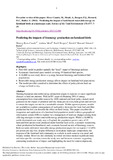JavaScript is disabled for your browser. Some features of this site may not work without it.
| dc.contributor.author | Rivas Casado, Monica | |
| dc.contributor.author | Mead, Andrew | |
| dc.contributor.author | Burgess, Paul J. | |
| dc.contributor.author | Howard, David C. | |
| dc.contributor.author | Butler, Simon J. | |
| dc.date.accessioned | 2016-10-25T12:02:32Z | |
| dc.date.available | 2016-10-25T12:02:32Z | |
| dc.date.issued | 2014-01-21 | |
| dc.identifier.citation | Rivas Casado M, Mead A, Burgess PJ, et al., (2014) Predicting the impacts of bioenergy production on farmland birds. Science of The Total Environment, Volume 476-477, April 2014, pp. 7-19 | en_UK |
| dc.identifier.issn | 0048-9697 | |
| dc.identifier.uri | http://dx.doi.org/10.1016/j.scitotenv.2013.12.080. | |
| dc.identifier.uri | http://dspace.lib.cranfield.ac.uk/handle/1826/10861 | |
| dc.description.abstract | Meeting European renewable energy production targets is expected to cause significant changes in land use patterns. With an EU target of obtaining 20% of energy consumption from renewable sources by 2020, national and local policy makers need guidance on the impact of potential delivery strategies on ecosystem goods and services to ensure the targets are met in a sustainable manner. Within agroecosystems, models are available to explore consequences of such policy decisions for food, fuel and fibre production but few can describe the effect on biodiversity. This paper describes the integration and application of a farmland bird population model within a geographical information system (GIS) to explore the consequences of land use changes arising from different strategies to meet renewable energy production targets. Within a 16,000 ha arable dominated case study area in England, the population growth rates of 19 farmland bird species were predicted under baseline land cover, a scenario maximising wheat production for bioethanol, and a scenario focused on mix of bioenergy sources. Both scenarios delivered renewable energy production targets for the region (> 12 kWh per person per day) but, despite differences in resultant landscape composition, the response of the farmland bird community as a whole to each scenario was small and broadly similar. However, this similarity in overall response masked significant intra- and inter-specific variations across the study area and between scenarios suggesting contrasting mechanisms of impact and highlighting the need for context dependent, species-level assessment of land use change impacts. This framework provides one of the first systematic attempts to spatially model the effect of policy driven land use change on the population dynamics of a suite of farmland birds. The GIS framework also facilitates its integration with other ecosystem service models to explore wider synergies and trade offs arising from national or local policy interventions. | en_UK |
| dc.language.iso | en | en_UK |
| dc.publisher | Elsevier | en_UK |
| dc.rights | Attribution-NonCommercial-NoDerivatives 4.0 International | en_UK |
| dc.rights.uri | http://creativecommons.org/licenses/by-nc-nd/4.0/ | |
| dc.subject | Farmland birds | en_UK |
| dc.subject | Ecosystem services | en_UK |
| dc.subject | Geographical information system | en_UK |
| dc.subject | Land use | en_UK |
| dc.subject | Renewable energy | en_UK |
| dc.title | Predicting the impacts of bioenergy production on farmland birds | en_UK |
| dc.type | Article | en_UK |
| dc.identifier.cris | 3630502 |
Files in this item
This item appears in the following Collection(s)
-
Staff publications (SWEE) [2825]

